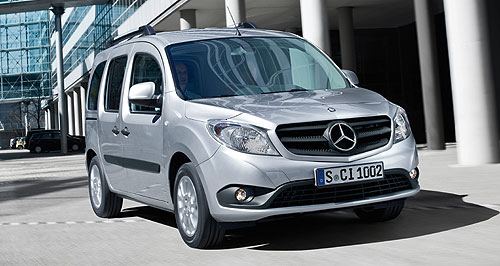News - Mercedes-Benz - CitanMercedes-Benz Citan van on the radar for AusVan plan: The current-gen Mercedes-Benz Citan is believed to be a chance to launch in Australia ahead of the next-gen version that is expected in about 2020. VW Caddy is in Benz’s crosshairs as Renault Kangoo-based Citan van moves into view24 Oct 2017 By BYRON MATHIOUDAKIS in CHILE THE smallest commercial vehicle offered by Mercedes-Benz Vans, the Citan, may arrive sooner than expected in Australia, with the current-generation version under consideration following news that the preferred powertrain option may become available. Now approaching its sixth year in production, the compact van has not been available with a diesel engine and automatic transmission combination, and it was thought that the local arm would have to wait until the next-generation model arrives sometime towards the end of this decade. However, the vehicle on which the Citan is based upon, Renault’s Kangoo, is about to score a six-speed dual-clutch transmission option next year for the 81kW/240Nm 1.5-litre four-cylinder turbo-diesel engine as an alternative to the long-serving six-speed manual, opening the door for the Mercedes version to follow suit. In Europe, both cars are also available with an 84kW/190Nm 1.2-litre four-cylinder turbo-petrol unit in either manual or auto guises. According to Mercedes-Benz Vans Australia PR and corporate communications manager, Blake Vincent, the German company would like to offer a direct rival to the Volkswagen Caddy, which currently dominates Australia’s small sub-2.5 tonne van market with a 56 per cent share. “We’re definitely looking at the next-generation Citan,” Mr Vincent told GoAuto at the first drive of the Mercedes-Benz X-Class pick-up in Chile last week. “In the past, we haven’t had access to the right powertrain combination … but there is still a chance we might see the current version if the right powertrain combination does become available. “It’s about getting that right for our market.” While information on the third-generation Kangoo and second-gen Citan is scant, it is understood that the next-generation versions will launch in about 2020, and will reportedly be based on a variation of the Renault-Nissan Alliance’s Common Module Family platform that underpins a host of models across Renault and Nissan’s portfolio, including the X-Trail and Qashqai. The Citan was released in Europe 2012, five years after the existing Kangoo was launched in Europe. More than just a facelift, the Mercedes-badged version underwent an extensive quality upgrade that included a stronger body shell, improved construction processes at the French factory where both vehicles are made, more effective soundproofing and stronger engine mounts. All were subsequently incorporated into the Renault version as part of the latter’s Phase II facelift the following year. Mercedes was looking to introduce the Citan to Australia as far back as 2013, but the plans were put on hold after the van received a below par three-star crash safety rating from Euro NCAP. Year-to-date sales to the end of September show that the Caddy dominates its segment with 1482 sales, a 15.5 per cent increase over the corresponding period in 2016, followed by the Kangoo with 642 units (down 25 per cent) and the Suzuki APV in third spot with 243 registrations (a slip of 32.5 per cent). Renault is confident the auto option will reverse the slide. A portmanteau of ‘City’ and ‘Titan’, the Citan can be ordered in Europe in three body lengths, two wheelbase sizes and in van or people-mover configurations, mirroring its Kangoo fraternal twin.  Read more25th of September 2017  First drive: Renault Kangoo ZE to cost $46K in OzAustralian business, government buyers the target for electric Renault Kangoo ZE24th of February 2017  Driven: Turbo-petrol Renault Kangoo touches downHigher output, lower running costs for new petrol-powered Renault Kangoo28th of January 2014  All too hard for Mercedes Citan van Down UnderBenz’s small urban van dropped from Australian wish list due to lack of diesel auto |
Click to shareMercedes-Benz articlesResearch Mercedes-Benz Motor industry news |
















Facebook Twitter Instagram